|
Monday, March 15, 2010
Progress Notes
This week once again we are honored to have been given another wonderful narrative written by former Miller County native, Bob Tyler (photo 01).
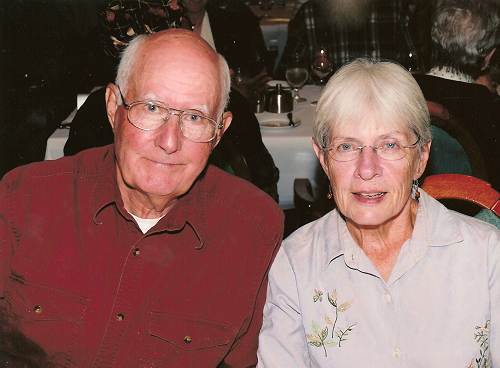
01 Bob and Alice Tyler The story Bob has submitted is a history of his grand father, Thomas Doubikin, originally from England who settled here in Miller County more than one hundred years ago. Readers may remember that Bob also wrote the very detailed and poignant story of his brother, Ace Tyler, who was a heroic WWII Air Force Pilot tragically shot down over France.
Another story Bob sent us was the story of Gail Popplewell, who was the uncle of Alice Steen Tyler, Bob’s wife. Gail was trained to be a gunner on B17 bombers. His 463rd Bombardment Group was cited for outstanding performance of duty in armed conflict with the enemy. You can read the outstanding record of his WWII Bombardment Group at this previous Progress Notes.
The Doubikin family is one of the true pioneer families of our county and its story is one of the more interesting ones to be found in Miller County history. One indication of the high regard given to the family is the number of narratives and references one can find on our website referring to the Doubikin name. For example, our website search engine renders 31 different references to the Doubikin family. You can locate the site search option at a new more convenient location on the website’s home page at the top right above the word “Museum.” Next to the blank space is the word “find.” Also, you can access a site search option on the Progress Notes page at the upper left under the “Main Links” drop box column where “site search” is the last of four selections.
Bob’s narrative is especially interesting due to the personal knowledge of the Doubikin family he has acquired being the grandson of Thomas Doubikin, the original Doubikin to have come to Miller County from England. Having had access to so many family members and family reunions through the years, Bob has a wealth of information to offer. Especially interesting is the research Bob and Alice acquired in the year 2000 when they made a personal tour to England to the Doubikin home area in the village of Wragby. On this trip many photos were taken and many personal oral histories were acquired to really give life to the story of Bob’s famous Miller County ancestor, Thomas Doubikin:
A GRAND OLD ENGLISHMAN
I never knew my Grandfather Doubikin. He died almost 20 years before I was born. However, the stories I have heard about him from my Mother always made me want to know more about him. Most of the information contained in this summary of his life has been obtained through material that was compiled and put in print by my cousin, Bertha (Doubikin) Harris and my brother Homer Tyler. I have added things that I accumulated such as pictures on a visit to England and knowledge about where he was born and grew into a young man.
My purpose for this writing is to try to summarize what both Bertha and Homer had previously done and to give readers an idea of who Thomas Doubikin was, and what impact he might have had in the development of Miller County. Genealogical information will be given in summary for the Doubikins in England first, then the family tree for Thomas Doubikin in more detail. Following this, I will attempt to give details of his life and accomplishments.
My great, great, great Grandfather was George Doubikin, born in Wragby, England in 1734. His wife was named Tamur and they had four children, John, Rebecca, Marianne, and James.
James was my great, great Grandfather and was born in Wragby, England in 1777. He was married to Sarah Rhoades in 1799 and they had eight children, including two sets of twin boys. One set was named James and George and the other set was John and James (two sons with the name James). This must have been confusing. The other children were George, Tamur, Sarah, and William. Up to this point the Doubikin’s lived in or around Wragby, England. Two views of All Saint’s Church in Wragby are shown below. This is where the early Doubikins are buried.
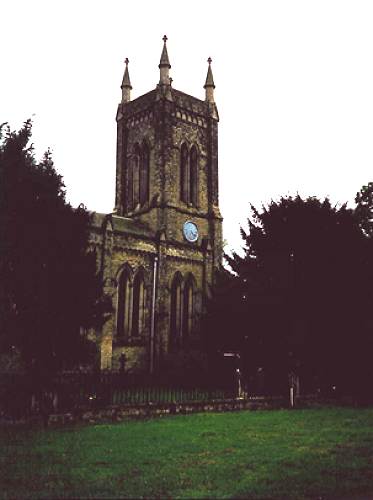
All Saint’s Church in Wragby, England 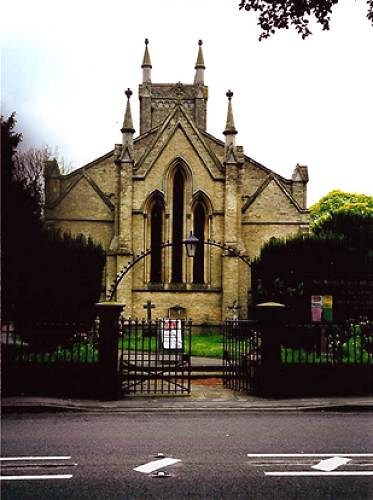
All Saint’s Church in Wragby, England John was my great grandfather, and he spent his life in or near Dunholme, England. He was married to Elizabeth Wilson in 1828 and they had two children, Mary Ann and Sarah. Elizabeth died in 1835; John married Marian Anne Kennington in 1836. There were eight children from this marriage. Their names in order of birth were James, Betsy, George, Thomas, John, Anne, Fowler, and Ann. Fowler died as an infant and Ann died as a young child. My grandfather was Thomas, born Mar. 9, 1846 in Dunholme. Great Grandfather John died Jan. 2, 1888, and Great Grandmother Marian Anne died Feb. 25, 1884. They are buried in the church cemetery in Dunholme, England which is shown in the pictures following.
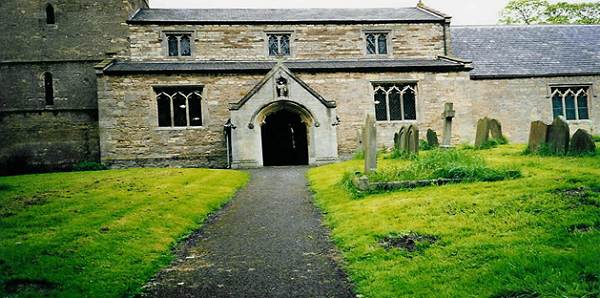
Front view of St. Chad’s Church of Dunholme, England 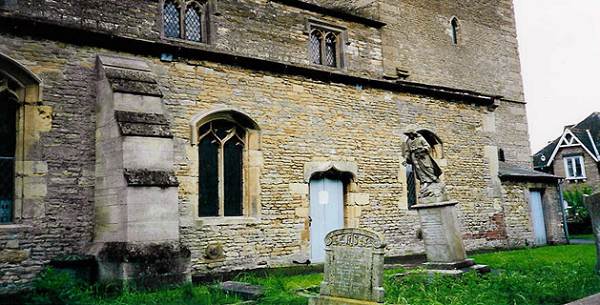
Back view of St. Chad’s Church of Dunholme, England 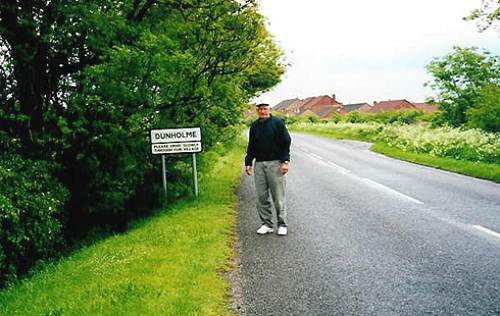
Bob Tyler by sign for Dunholme taken in 2000 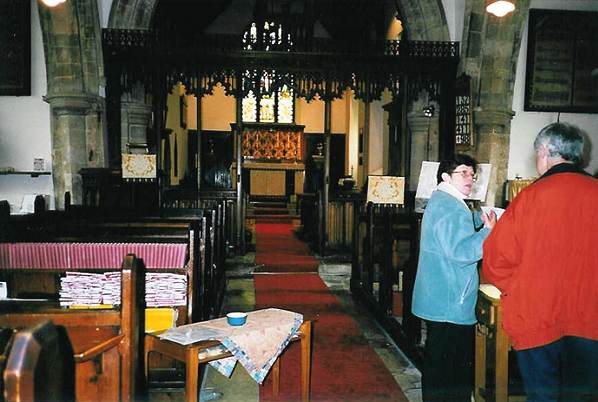
Inside St. Chad’s Church Alice and I visited this church and cemetery in 2000. We were able to see the church record of births and deaths and the graves of my Great Grandfather and Grandmother. The church dates from the early 14th century.
At the age of 22, my grandfather, Thomas Doubikin decided to come to America. The reason I had always heard was that since the first-born son (James) would inherit the land in England, Thomas decided life in America would be better for him. His brother George also came to this country at the same time, but did not like it here and returned to England. There were also three cousins of Thomas (sons of James, the twin brother of Great Grandfather John), who came to America about the same time and settled in Ohio.
The best information we have is that Thomas came to this country in late 1868. He landed in Boston and spent about two years working in that area and became a United States Citizen. He came to Missouri in 1871 and settled in Miller County. He bought a farm on the Big Tavern Creek and began his life as a farmer.
The family of John Hensley had settled in Miller County in the early 1850s, coming from Cole County. Their farm was in the vicinity of the Doubikin farm and Thomas evidently became a friend of some of the Hensley children. Bertha (Doubikin) Harris says he was a friend of Ben, Joseph, and Thomas Hensley, but it appears he really had his eye on the youngest of the nine Hensley children, Nancy Ellen.
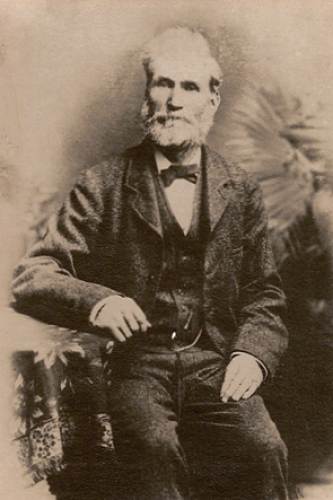
Thomas Doubikin
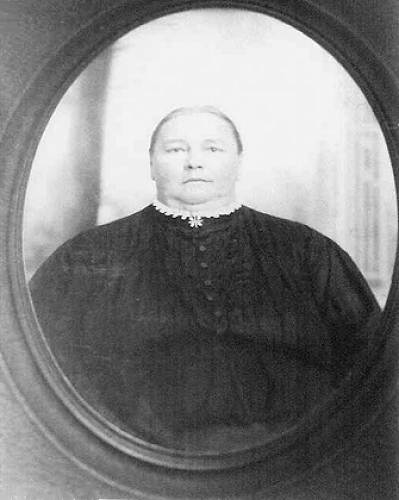
Nancy Ellen Hensley Doubikin Grandpa Thomas and Grandma Nancy married on Dec. 14, 1873. Six children were born to this couple, five girls and one boy. The first child was Elizabeth (Lizzie). She was born in 1875 and married Thomas Gray in 1894. They spent most of their life in Oklahoma, homesteading in 1900. They had two children by this time, Mary Ann, born in 1895 and Thomas, born in 1898. They traveled about 600 miles to western Oklahoma in a covered wagon with the two small children. They started in a sod house with Indians as their closest neighbors. Four more children, all boys, completed this family. Walter was born in 1903, John in 1906, Charlie in 1908, and Willie in 1911. Of the six children, Mary Ann was the only one who settled in Miller County. She married Dave Bailey and had two children, Jewell (married William Hixenbaugh), and Zella (married Gilford Barr).
The second child of Thomas and Nancy Doubikin was Mary Jane, born in 1876. She married David J. Snelling in 1896 and had eight children. These were from oldest to youngest, Corney, Elizabeth, Nora, Bessie, Earl, Lura, Victor, and Velma. Although their early life was in Miller County, they spent most of their life in or near Kansas City. I was young when they moved from Miller County; therefore I was not fortunate enough to get to know Aunt Mary’s family very well.
The next child of Thomas and Nancy was Dora Ellen, born in 1879. She was married to Joseph McDonald in 1896 and they had eight children. The oldest was Elsie who first married Perry Burks and then George Roark. The second was James Irvin (always known as Irvin). Irvin’s first two wives died fairly young. They were Lena Bass and Maudie Shockley. His third wife was Nellie Helton. The third child was Evelyn, who married Fred Stark. The fourth was Thomas, who married Fern Alexander. The next was William Gay (known as Gay). He married Gladys Sherrel. Walter was the next child. He married Helen Marble. Walter became a career Navy man, experiencing the Pearl Harbor attack aboard the battleship, USS Oklahoma. I came to know Walter quite well since we happened to serve aboard the same ship during the Korean War. The last child of this couple was Ernest, born in 1913. He married Anna Christiansen. Of this family, I knew Irvin and his family well, since he lived most of his life in and around Iberia. Of course I knew Walter while in the Navy and Ernest would come see us and go quail hunting quite often. I have fond memories of Aunt Dora in her later years. She would come to visit my mother, and although she was almost blind, she maintained an active life and was a joy to be around.
The next child of Thomas and Nancy’s was John Walter, the only son in the family, born in 1883. He was always known as Walter and Uncle Walter to me and my siblings. He married Annie Shockley in 1902, and started his married life on a tract of land adjoining his parent’s. The first child to this union was Bertha, born in 1903. Lonnie was born in 1904, and would be the only son in this family to survive. Dorothy was born in 1906 and Lillie in 1907. A son, John Walter was born in 1913, but did not survive infancy. Our family always visited a great deal with Uncle Walter’s family, and I have fond memories of spending a week or two of summer vacations on the Doubikin farm. Below is a picture of Walter and Annie with their first child, Bertha.
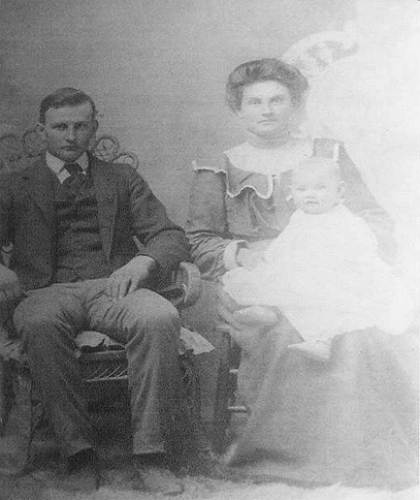
Walter, Annie and Bertha Doubikin @1904 Emma was born to the Thomas Doubikin family in 1888. She married Fred Gardner in 1914 and they had one son, Raymond. Emma’s family lived in the Iberia area the rest of their life.
The last child who came to the Thomas Doubikin family was my mother, Minnie Grace. She was born in 1893 and married Barney Tyler in March, 1911. There were six children in our family, Norma, Ace, Homer, Don, Bob, and Alta. One child, Otis died as an infant.
So Thomas Doubikin and Nancy Hensley married and raised six children. These six children had 33 children that lived to adulthood. Now there are many, many more that are part of the family tree. It is unusual, and sad, however, that there is not even one to carry on the Doubikin name. The only son was Uncle Walter and he had only one son, Lonnie, who lived to adulthood and had no children. He died young, at the age of 54. The Doubikin farm now belongs to John D. Hammons, the only child of Lilly Doubikin, who married Freeman Hammons.
Following this summary of the family of Thomas Doubikin and Nancy Hensley, I will attempt to relate the development of the Doubikin farm and significant happenings in the life of Thomas Doubikin. I am indebted to Bertha (Doubikin) Harris, my cousin, and my brother, Homer, for their previous writings of the genealogy and history of the Doubikin family.
My grandfather, Thomas Doubikin, purchased land in Miller County on the Big Tavern Creek in 1871, after migrating from England in 1868 and spending about two years in or near Boston, Massachusetts. After living alone on this farm for a couple of years, he married Nancy Ellen Hensley whose family were neighbors. Very soon after starting married life, he began to build farm buildings to support work on the farm. One of the first was a small building near the house that in later years was a tool shed, but had possibly been used for a smoke house, or even a temporary dwelling while the main house was being constructed. Just to the right of this building was a gate to the barn lot and on the gate post was a large bell. This bell was rung at dinner time (lunch to most today), to call in the workers from the fields. It could also be rung (with a different kind of ring) in case of an emergency. If the neighbors heard this ring, they would drop whatever they were doing and come to help.
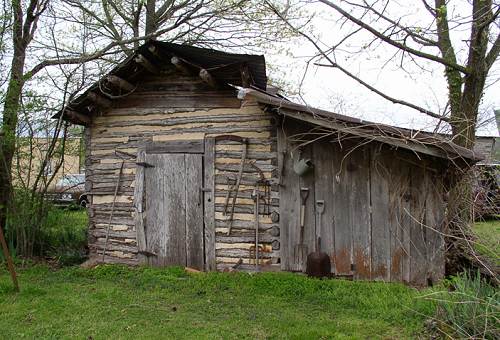
Tool shed circa 1877 Probably close to the same time, construction of the barn was begun. As Bertha said, “A good barn was crucial to the development and success of a farm”. It is not known for sure what year this barn was built, but it is believed to be @1877. This barn was large and enclosed by a fenced lot with several other buildings, which came later. These included granaries, sheds, and a building with scales for weighing wagons or livestock. The barn was well-built with wooden pegs holding the large timbers together. It was in use until an ice storm in 2005 caused it to collapse. It had survived about 128 years.
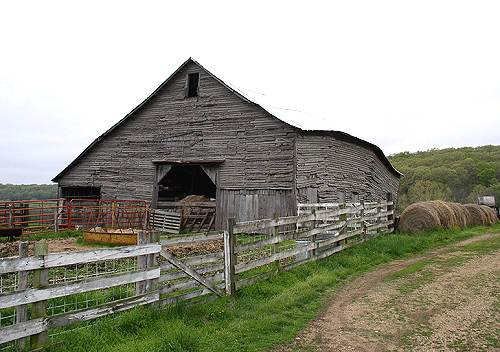
Doubikin Barn circa 1877 Thomas Doubikin traveled back to England for a visit in 1873. He was gone for about two months. It would take three weeks by boat each way, plus the train travel from Missouri to Boston and return. So he would spend about a month in England visiting his family. The pictures which follow were taken in England and include Thomas Doubikin and possibly his home in Dunholme, England.
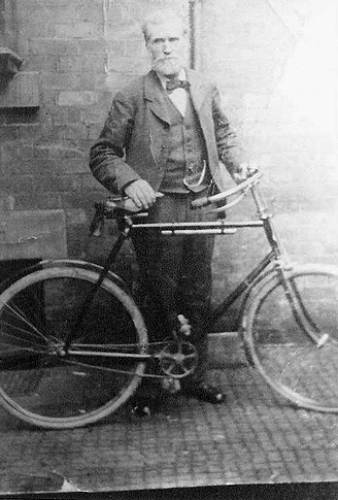
Thomas Doubikin 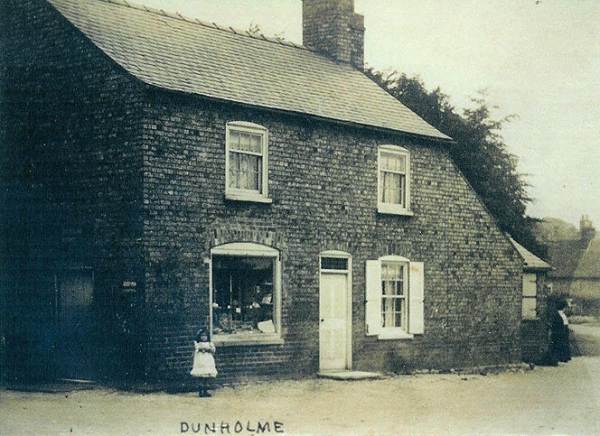
Dunholme, England Later in 1873, after returning home, he married Nancy Hensley. Early in his married life, he established a post office which was located in the Doubikin home, along with a small store. He called this post office Caenby Corner. This was a name he took from his homeland. It was the name of a small village at an intersection, now having a “round-about”. This village was a few miles from the village of Dunholme. The pictures below show Caenby Corner in England as it appeared in 2000.
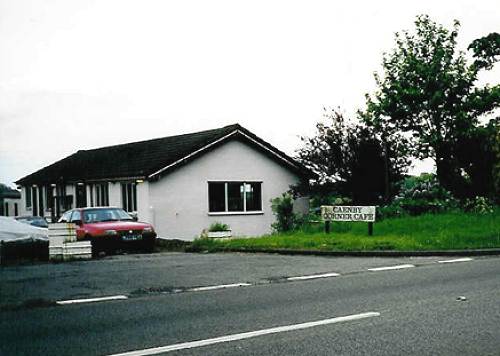
Caenby Corner, England in 2000 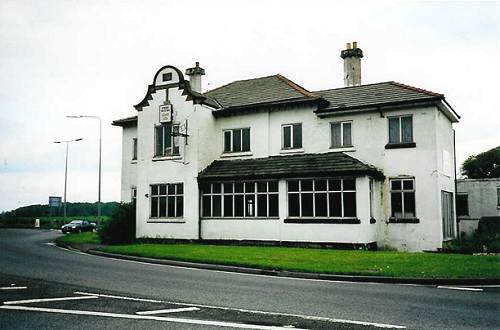
Caenby Corner, England in 2000 Thomas Doubikin also helped establish a post office at Ramsey and at Claxby. Ramsey was near what is now Capps, and Claxby was about six miles east of the Doubikin farm which was called Caenby Corner.
In the early years of the Doubikin farm there were no stock laws, so cattle had a free range. Thomas and his neighbors were helpful in getting laws passed, which required farmers to fence their land to control grazing boundaries. In regard to his neighbors, I had been told many times by my mother, and by Bertha, how the neighbors of the Doubikins were so helpful and important in their lives. All these neighbors were of German heritage, the Schulte’s farm adjoining east, the Otto’s just further east, the Blomberg’s to the south, and Heckemeyer’s to the north.
So, the family grew and in 1893 the last child was born. This was Minnie, my mother. She often talked of and showed copies of old letters from family in England. Sometimes, they were letters “edged in black”, telling of the death of a family member. My mother said that her Dad’s favorite in his family was his sister, Annie Clay. It may have been because she was the one who most often wrote letters telling the news. In June, 1898, after summer crops were in, Thomas planned another trip to England. It had been 25 years since he had been there. Three children were still home at that time, Walter was 15, Emma was 10, and Minnie was 5. I can imagine, how some, or all of them, wanted to go with him to England. Bertha relates that she thought their mother was afraid they might get hurt on such a long trip. They would, however, help him prepare for the trip. He would pack some corn in his bags to show his family, since they did not grow corn in England. The kids also caught fireflies and put them in a bottle for him to show his family, since they did not have fireflies there. As mentioned before, the trip by boat took about three weeks. He normally traveled on the Cunard Lines which traveled from Boston to Liverpool. Before, taking this trip, he asked the Government to close the post office at Caenby Corner. Patrons now could pick up mail at Ramsey or Claxby.
Below is a picture probably taken around 1900, showing the three younger children and Thomas and Nancy in the yard of their home.
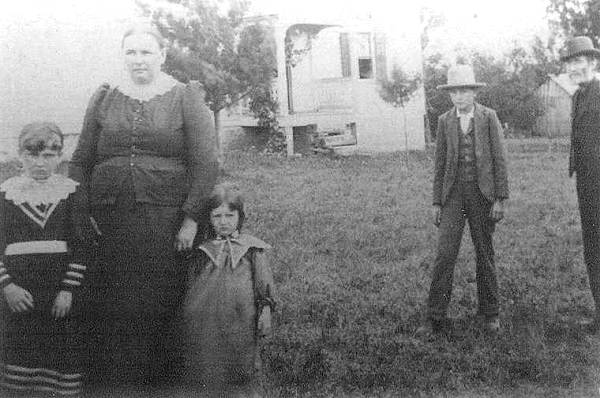
Doubikin family @1900 - Emma, Nancy, Minnie, Walter and Thomas In 1902, Walter married, lived on, and farmed a portion of the original farm. In this same year Thomas again visited England. A copy of the passenger list is shown on his departure from Liverpool for his return voyage aboard the Ivernia on Nov. 4, 1902. The entry with the heavy dark mark is the entry for Thomas Doubikin. Note that his home address is given as Ramsey, Missouri.
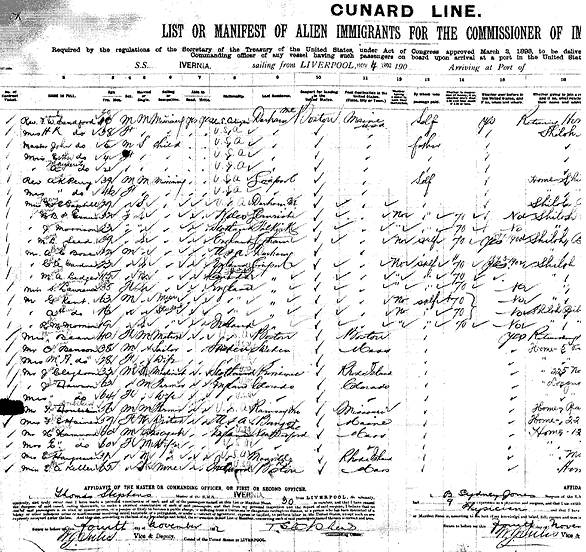
Ivernia Passenger List - November 4, 1902 In 1905, Thomas again was on his way to visit his homeland. Shortly after leaving, however, the farm house burned. Family tried to send word to him before he left St. Louis on the train, but could not contact him. A telegram was waiting for him when he got to Boston and he canceled his trip and returned home. A new house was built and is shown in the following picture.
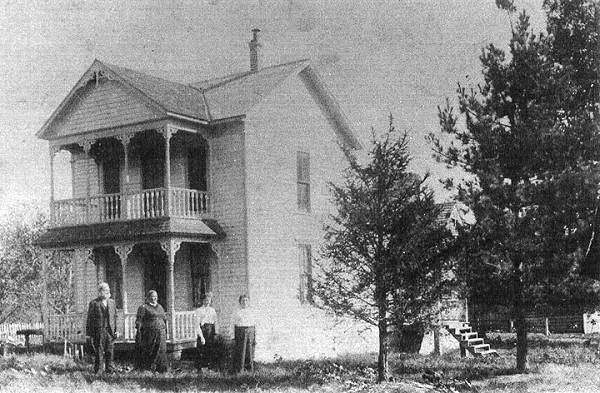
Thomas, Nancy, Minnie and Emma in front of new house circa 1906 Grandpa Doubikin’s health probably began to worsen around 1907, and he decided to sell the farm. Frank Kroll of Jefferson City bought the farm and Thomas bought a farm just on the outskirts of Iberia belonging to B.H. Crane. So they moved to Iberia in 1907. Emma and Minnie were still home at that time. Walter lived on a farm adjoining the old Doubikin farm. In 1911, Grandpa Doubikin again was making plans to visit England. He had developed a stomach problem and was to have surgery. His plans were to go to England after recovering from the surgery and had booked his passage. Again, he had a reservation on the Ivernia of the Cunard Lines. It is interesting to note that this ship was sunk by a German submarine in 1917. The planned trip did not occur, however, since he did not recover from the surgery and died in Barnes Hospital in St. Louis on April 11, 1911.
Later in 1911, Walter bought the farm back from Mr. Kroll, and the farm has remained in the Doubikin family since that time. So except for that 4 year span from 1907 to 1911, the farm had remained with the Doubikins. This is a total of 135 years.
Bertha often told of talking to people who had known Thomas Doubikin. They all gave similar descriptions of him. This was that “he was a much loved neighbor, a friend to all, a staunch community leader, a promoter of country betterment, and a good provider for his family.” A couple of stories she told made her proud and gives more insight into the kind of person he was. She had stopped at the train station in Crocker to pick up a sewing machine she had ordered. When the agent saw that her name was Doubikin, he commented: “There was a wonderful old Englishman with that name who shipped cattle from here.” Bertha proudly responded, “He was my Grandfather.” Another person referred to him as that “Grand Old Englishman.”
I have many fond memories of visits to the Doubikin Farm. When Don and I were very young Uncle Walter and Aunt Annie would invite us to come and stay with them for a week or so in the summer. They would say it was to help them on the farm, but I doubt that we were much help. We spent a lot of time fishing, exploring, and looking for arrow heads. The land on and surrounding the farm evidently was important in the life of the Osage Indians. Many arrow heads and other artifacts were found and Bertha and Fred Harris had quite a nice collection. Across the creek to the South were also Indian Mounds, either burial or ceremonial grounds. So this area was important tribal lands. In later years, when our kids were young, Don and I would take everyone to the farm for a day of fishing. Bertha and Fred Harris lived there at that time, and he had stocked ponds with catfish. The days usually ended with a big fish fry.
As I noted in the beginning of this story, I have always wished I had been able to know my Grandpa Doubikin, that “Grand Old Englishman.”
Bob Tyler
February, 2010
Thanks Bob for the time and effort you took to put together this very interesting story of your Doubikin ancestors, and in particular, your grandfather, Thomas Doubikin.
On our website are some other briefer narratives about the Doubikin family. Peggy Hake wrote about the relationship of the Doubikin, Hensley and Shockley families which you can read there (scroll down the page to reach it).
Another short history of the Doubikin family written by Bertha Doubikin Harris can also be found on our website.
A delightful history of the Caenby and Claxby Post Offices established by Thomas Doubikin has been written by Kelly Warman-Stallings.
Also, you can read about one of Thomas’s sons, John Walter Doubikin, who was featured by Miller County Historian Gerard Schultz in his book, “History of Miller County.”
One of the Doubikins I knew was Lonnie Doubikin, son of John Walter Doubikin (photo 02).
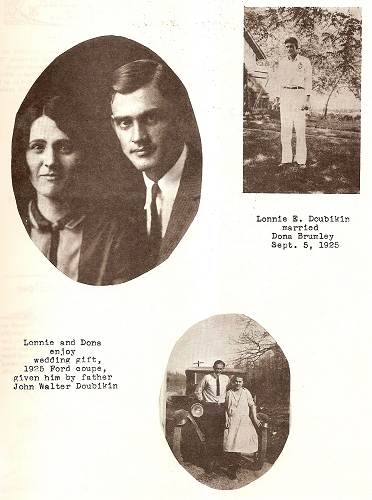
02 Lonnie Doubikin
Click image for larger viewLonnie was very active in the Tuscumbia Saddle Club back in the early 1950’s and that is where I usually saw him. He had a beautiful black five gaited horse, I remember. Lonnie was married to Dona Brumley who was a distant cousin of mine through the Forrester line.
You can locate the original Doubikin farm identified as J.W. Doubikin in this 1930 plat map of Osage Township in sections 30 and 31 of Osage Township 40N Range 12W (photos 03 and 04):
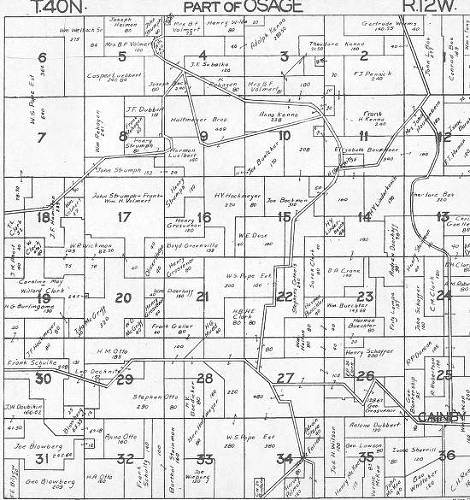
03 Osage Township - T40N-R12W - S30 and 31 - Doubikin Farm
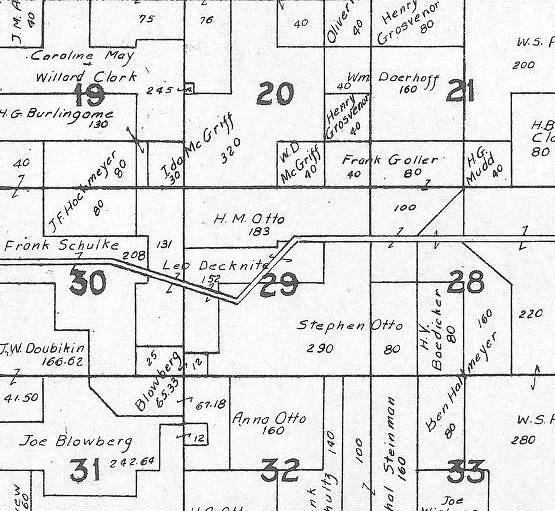
04 Osage Township - Doubikin Farm - Closeup of Sections 30 and 31 The current owner of the historic Doubikin farm is John D. Hammons, the son of Lillie Doubikin Hammons, grandson of Walter Doubikin, and great grandson of Thomas Doubikin. He lives in the Sedalia/Smithton area where he is in the trailer construction business.
The Doubikin farm is located on A road about six miles south of Tuscumbia off Highway 17. At the junction of the two roads is located one of the higher elevations in the county. Looking north it seems as if the hills in the background are many miles away (photo 05).
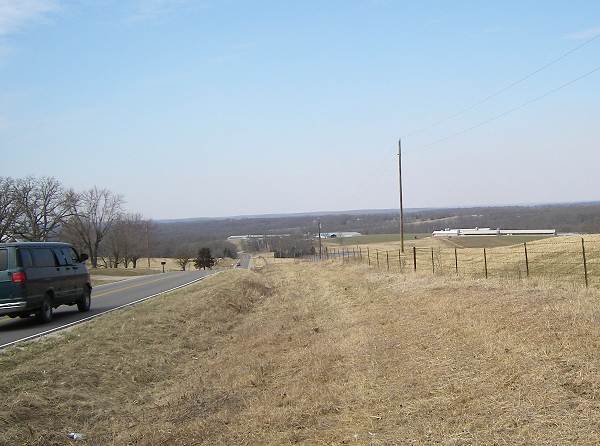
05 Intersection of Highways 17 and A looking North Driving about six miles east on Highway A takes you to the Doubikin farm where the home is located close to the highway (photo 06).
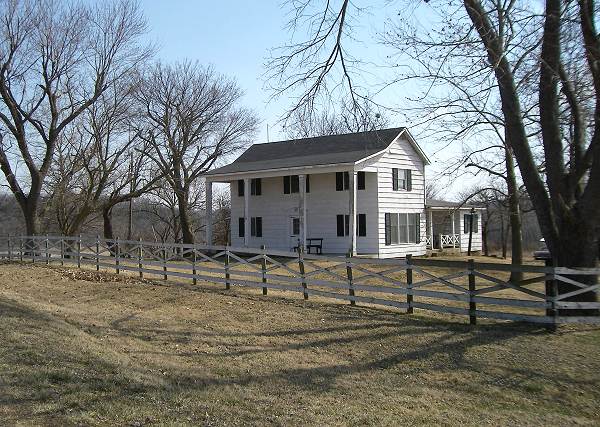
06 Doubikin Home About a quarter mile further down the road you reach the one lane bridge crossing the Tavern Creek. This photo is from the middle of the bridge looking south (photo 07).
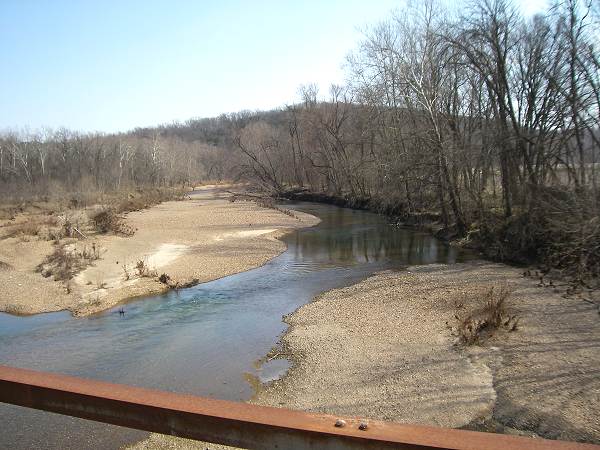
07 Big Tavern looking Upstream Even though it is still winter a quiet beauty is felt as one gazes at the hills and hollows of the Tavern Creek valley (photos 08, 09 and 10).
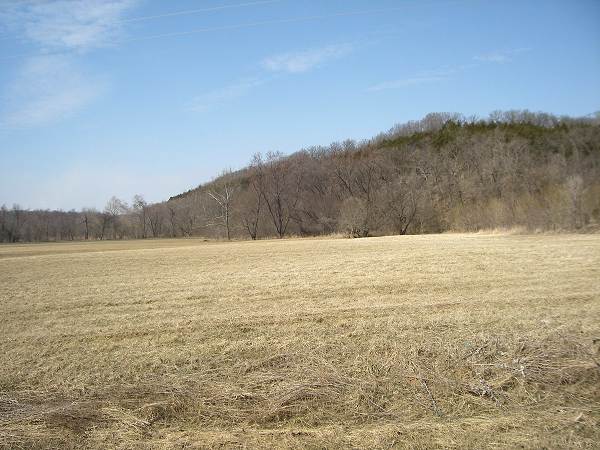
08 Big Tavern Valley
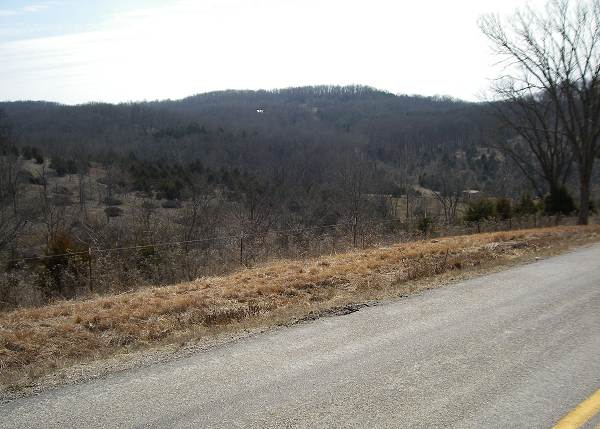
09 Small valley East of Doubikin Farm
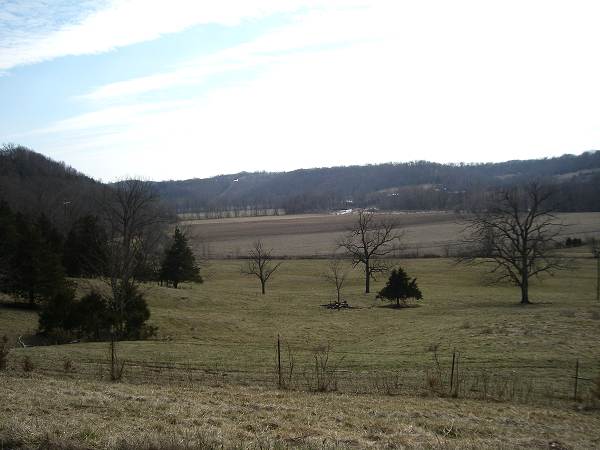
10 Valley South of Doubikin Home Thanks again, Bob, for sharing the memories of your Doubikin family ancestors with such an interesting narrative and wonderful photographs!
A couple of months ago I wrote about Joe Crismon, the second to last Miller County Civil War veteran to pass away (John Ferguson was the last).
The Crismon family came up for discussion again recently between myself and my brother in law, Al Cates, who now lives in Texas. Al confirmed a story I had heard that there was a “Catt Crismon” who ran a gas station in Al’s home town of Maynard, Arkansas, a small town just across the border from Missouri east of Springfield. Catt’s given name was Austin Melrose Crismon.
I became curious enough that I asked Nancy Thompson our museum director who also is a first class genealogist to explore the history of the Crismon family and its descendents. You can read her complete research effort at this attachment (photo 11).
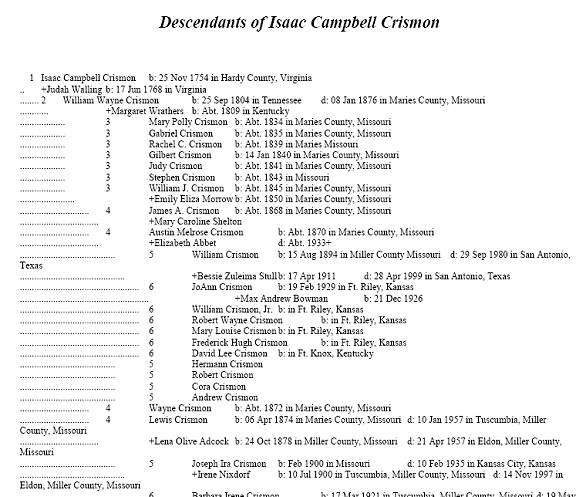
11 Descendants of Isaac Campbell Crismon
Click image to view full document in PDF format.From her research I learned that the Crismons’ lived in both Maries and Miller County. Joe Crismon mentioned above is of this family. Going down the line of descendents Nancy listed I quickly found the name Austin Melrose Crismon, who by the way was married to an Abbett, one of my ancestral family names. I researched some more on the internet to find additional information about Austin Melrose (Catt) Crismon and found a website written by members of the Crismon family whose ancestors had moved out of Miller County quite a few years ago. Here is the first of two stories I found interesting:
Colt Single Action Storekeeper’s Model
The year was 1933. Austin Milroy “Catt” Crismon took keen interest in the empty flat bed Ford truck that pulled up to his Mobil Oil filling station, the only gas station still open in town. The other one closed when the bank failed several years back. Catt had not seen the truck before and with Maynard, Arkansas being a very small town, he knew every local car, truck, and any people that might come to town. Maynard was close to the Missouri state line. However, folks just didn’t usually come through Maynard on their way north as better roads existed close by to the east and west of Maynard. To see a stranger in town was unusual! With no one else in the store, Catt went outside and asked the driver now standing outside of the truck if he needed gas. Another older man was standing at the opposite side of the truck. When the young taller one said, “Fill ‘er up, Pop” Catt immediately became suspicious. Why, it had been perhaps months since anyone said fill the tank. It just wasn’t done. First off, most local folks didn’t have the cash to spare all at once. Times were tough back during the depression. Secondly, and much to Catt’s displeasure, folks would say, “Give me a gallon.” This really griped Catt as he knew the person wanted just enough gas to get him to the Missouri state line just six miles away. Not only was gas cheaper in Missouri, but the state sales tax was several mills less. Catt understood his neighbor’s motivation, but it still chapped him some. Now with these two stranger fellers saying fill the tank, Catt figured that he had better be very aware and careful here. Catt mumbled something about being right back and went into the store. Now the word “store” was somewhat of a stretch. Shelves offered a few staples like flour, sugar, tobacco, and such but no food items needing refrigeration were stocked.
Catt was no stranger to Colt Single Actions; he had purchased his first one in 1885 at the age of 16. He reached under the cash drawer and took out his nickel plated Colt Single Action revolver. It was a .45 caliber gun with a 3 ½ inch barrel and known as the “Sheriff’s Model”. This same type of gun was also referred to as the “Storekeeper’s Model.” These were not names actually assigned by Colt. The purpose of these short barreled revolvers was they could be more easily concealed when carried or the gun could be strategically placed somewhere for quick access. About 85% of the guns had either the 3 ½ or 4 inch barrel. Most guns were manufactured in .45 COLT caliber. The first shipments were made in 1882. The last black powder version was shipped in 1899. The last smokeless powder Sheriff’s Model gun was shipped in 1927. While the exact number is not known, it is estimated that about 1,200 of these unique Single Action revolvers were manufactured.
In the store Catt stuck his Sheriff’s Colt Single Action inside his belt and made sure it was concealed by his jacket. Outside as he pulled the pump lever back and forth to manually fill the glass pump barrel to the 10 gallon mark, he remained aware of where the two men were. The driver remained close to Catt while the other sauntered into the store. Catt informed the stranger what the gas cost was and the man gave him a twenty dollar bill. As Catt went into the store to make change he noticed the other man was still inside the store and close to the door. The man outside started up the truck. As Catt stepped behind the counter to open the cash box, he drew his Sheriff’s Model Colt and kept it in his right hand out of site while keeping a wary eye on the stranger. Yep, just as he expected, the stranger started to draw a handgun from his coat pocket. Before the robber could bring his gun up to firing level Catt fired off three quick shots! All three missed the would-be robber who ran out of the store, gun in hand. Black powder gunsmoke filled the small store. By the time Catt could find his way through the gunsmoke and to the front door the truck was speeding down the gravel road with the gunman robber desperately clinging onto the bed of the truck.
Catt looked at the twenty dollar bill in his left hand and thought, “That’ll just about pay for the broken windows I shot out!”
The Maynard Jail shown below is located on property next to the house once owned by Catt. That was his home with the porch to the left of the jail. The buildings to the right of the jail are the Maynard Community Center and City Hall. In 1956 the families of Mary and Bob visited Grandpa at this house and examined the jail. When asked if anyone was ever thrown into the jail, Grandpa replied, "Old Charlie gets drunk about once a month when his retirement check comes in and the Town Marshall lets him sober up in the jail." The jail is about six by six feet in size. A normal sized man could not stand up inside the jail. No facilities exist in the jail. The bars of the door were made from straightened out old wagon wheels. Other than Charlie, it's doubtful anyone was ever held in this jail more than once. Perhaps we need more jails like this today!
Here is a photo of the Maynard Jail (photo 12):
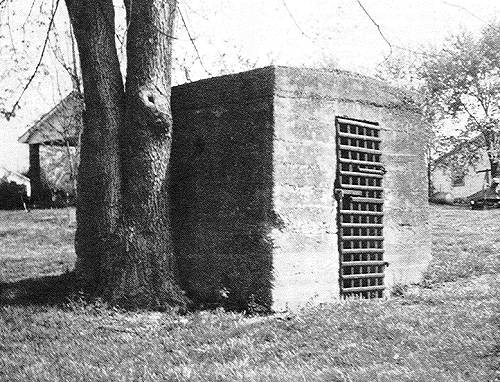
12 Maynard Jail I thought it somewhat interesting that the Maynard Jail is of the same concrete design and construction as the old Iberia Jail (photo 13).
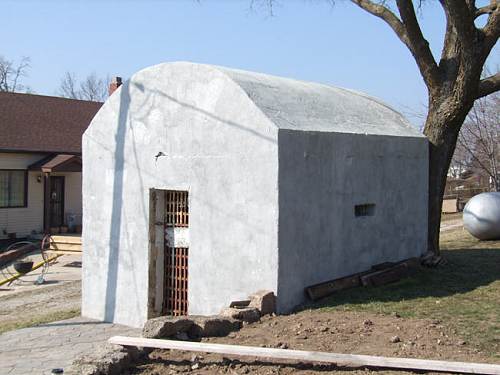
13 Iberia Jail Whether Catt had anything to do with that is hard to know. Al Cates was a young boy in the 1930’s. Catt would have been in his mid sixties then.
Further research by Nancy Thompson located an old obituary of Emily Eliza Morrow Crismon, wife of William J.Crismon, and mother of Catt Crismon as well as eight other children who survived. One of them was Louis Crismon, who remained in Miller County and at one time was on the Miller County Court. The obituary is old and hard to read but you can take a look at it (photo 13a).
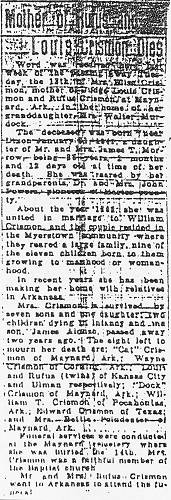
13a Obituary for Emily Crismon
Click image for larger viewAccording to the obituary, Emily passed away in Maynard where she was living at the time.
The story of Catt’s son, William Crismon, also is interesting and is copied here from the same website:
William Crismon after Boot Camp
William (none) Crismon was born on August 15, 1894 on a farm in Miller County, Missouri. His father, Austin Melrose “Catt” Crismon and several family members built the log cabin with a sod roof. His mother, Elizabeth (Abbet) said he was just too small of a baby to be burdened with a middle name.
While the Crismon Clan in Missouri was considered to be well off in those days, we don’t know why Pop’s family was not for awhile. Pop's Great Grandfather, William Wayne Crismon, Sr., was an early settler in Missouri and owned considerable property that was passed down. In later years Catt seemed to do well financially, having owned a business and a number of farms over the years. We suspect the plight of the Catt Crismon family had much to do with the fact that Elizabeth died from drinking tainted water when Pop was only seven years old. Her untimely death left Catt with four boys and an infant daughter to raise – plus work the farm. At Elizabeth's funeral two month old baby sister Cora was handed to Elizabeth's sister to raise. Baby Robert was placed in an orphanage in St. Louis. Pop was taken in by Catt's brother, Lon. The remaining boys, Andy and Herman, remained with Catt to work the farm.
In November 1912 William enlisted in the U.S. Army at Jefferson Barracks, Missouri, just outside of St. Louis. As a matter of fact, he said the only town he remembered visiting before was Tuscumbia, Missouri. Pop said during the train ride to St. Louis he wore his first pair of new shoes. Pop saw a U.S. Army recruiting poster on the train and decided that is what he wanted to do with his life. William was underage and did not meet the minimum weight enlistment requirements. His brother Herman paid the camp cook twenty dollars to give Pop a job at the mess hall and "fatten him up". Even at age 18 Pop still didn't meet the weight requirements and it took several more months before he did. At enlistment Pop was practically illiterate having gone to school only through the third grade. A friendly officer began teaching Pop how to read and write during war time in France. Pop was a fast learner and later was appointed First Sergeant of his Company. Pop successfully attended a number of military schools and earned a vocational technical certificate in photography after retiring from the Army. He continued practicing his penmanship even as an old man.
This photo of Pop was taken by Pop's brother Herman at Pop’s graduation from boot camp:
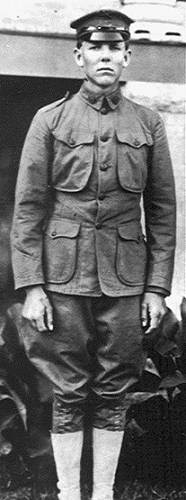
William Crismon Notice the jacket is much too small, almost bursting at the buttons and short at the sleeves. Did the Army chow fatten him up? And what unusually large pockets. The breeches are unusual as well, perhaps they were made of canvas or leather. We wonder if the shoes were Pop’s new ones. After boot camp Private Crismon was transferred into an artillery company at Fort Sam Houston, Texas. There he was named the company carpenter.
During most of his military career Pop served in the Cavalry. Private Crismon served on the Texas/Mexico border in 1916-17 chasing Pancho Villa. He was on the first boat load of soldiers shipped to France during WWI. He remained stateside during WWII. Corporal Crismon was awarded the Silver Star in France for battlefield valor on December 31, 1918. Later he was given a battlefield promotion to Sergeant. After the war Pop was stationed at Fort Riley, Kansas for about 22 years and was part of the U.S. Cavalry School cadre.
Pop married Bessie Zulema Stull in 1927. He was stationed at Fort Riley at the time. Their first five children: JoAnn, William Junior, Robert Wayne, Mary Louise, and Frederick Hugh were born at the Fort Riley Post hospital. Pop was stationed at Fort Knox, Kentucky at the time the last son David Lee was born. About that time the children with great fondness and respect named him "Pop". Master Sergeant William Crismon retired from the military in 1943 after 30 years of service. He and Bessie then moved their family to San Antonio. All six of the children attended the South San Antonio High School.
During his long retirement Pop enjoyed playing poker! His favorite game was "Texas Hold'em." As a retired serviceman he could fly free on US Air Force planes and he traveled extensively. Material things were of no interest to Pop, family was. In his later years when traveling around, a small overnight bag contained all of the necessities his life style required. William Crismon died on October 1, 1980 in San Diego. Bessie died April 28, 1999. They are both buried at the Fort Sam Houston National Cemetery in San Antonio, Texas.
One of the interesting things I have noticed since working with the Miller County Historical Society is that some people out of every family seem to have moved away to other states. Many reasons account for this phenomenon I would imagine including economical ones, marriage or just plain wanderlust. A family as large as the Crismons’ was sure to have a number of its members move away. Sometimes it is interesting to follow up on their stories just as I have done this week with some of the Crismon family.
In a previous Progress Notes of last year I wrote a story about square nails and Green Lee Wright’s first acquaintance with them.
A couple of weeks ago Vice President Carl McDonald brought to our museum a collection of square nails he had saved from the Lupardus Cabin when it was disassembled for transfer to our museum campus. If I would have had Carl’s collection last December I could have inserted a photo of it with the narrative of Green Lee Wright. However, better late than never so here is a photo of Carl’s recent donation (photo 14):
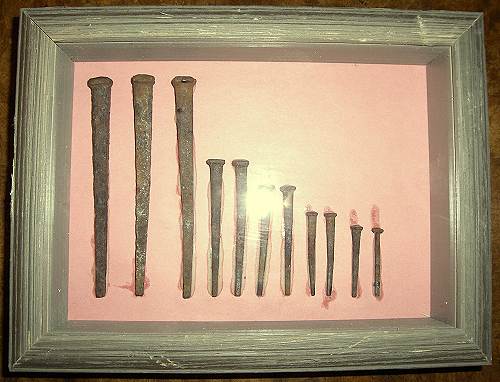
14 Old Square Nails from Lupardus Cabin donated by Carl McDonald
Here is a photo I copied off the internet that someone recently took of the old Tuscumbia bank and Presbyterian Church (photo 15):
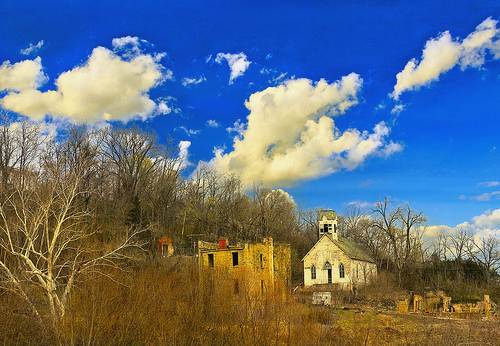
15 Tuscumbia Today It obviously was taken in winter on a bright sun filled day. Of course, both the bank and church have been abandoned for many years now, as have quite a few other structures in Tuscumbia if they are still standing. One of my goals when joining the Miller County Historical Society was to collect old photos of Tuscumbia along the Osage River bank when that area of town was the center of activity. Compare the recent photo with these two photos of the church and bank taken over a hundred years ago (photos 16 and 17).
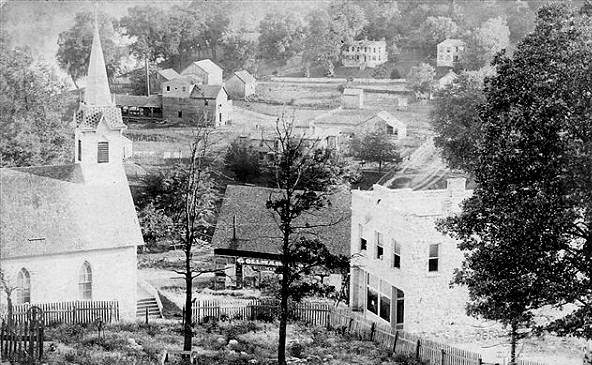
16 Goosebottom from above Presbyterian Church
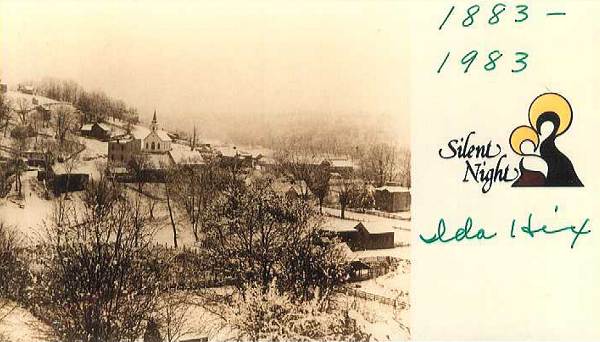
17 Christmas Scene Card from Ida (Hauenstein) Hix
Click here to watch a recent MODOT Minute giving an update on the construction of the Osage River bridge in Tuscumbia:
You may have noticed last week that we have rearranged the archives of previous editions of Progress Notes according to month and year at the top of the web page. This change puts the links off site allowing the page to be shorter as well as eliminates the need to scroll a long distance before you find the date wanted. Thanks go to Wayne Johnson, web site designer, and David Statler, Progress Notes director for making this change possible. In the future we want to index the Progress Notes according to subjects covered, but that is a project requiring much time which is a luxury a volunteer organization often lacks.
That’s all for this week!
 Joe Pryor
Article links are in a dropdown menu at the top of all of the pages.
|

